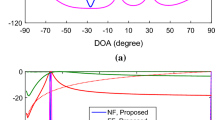Abstract
In this paper, a new multiple signal classification (MUSIC)-based source localization algorithm is proposed to localize a hybrid of near-field (NF) and far-field (FF) sources. The MUSIC estimator for localizing the FF sources is referred to as the FF-MUSIC estimator. On the other hand, the NF-MUSIC estimator is designed for localizing the NF sources as well. In between the processing of these two estimators, the Capon spatial spectrum is exploited to reconstruct a pure NF covariance matrix. The proposed algorithm requires only several one-dimensional (1-D) spectral searches and does not involve any computations of high-dimensional iterative optimization, higher-order cumulants, and parameter pairing. Unlike the existing algorithms, which are derived based on the second-order Taylor series approximation, i.e., Fresnel approximation, of the spatial phase factor, the proposed algorithm is applicable to any-order expansion of the spatial phase factor. Moreover, it works well for non-uniform arrays, whereas the existing algorithms can only be applied to uniform arrays.




Similar content being viewed by others
Data Availability Statement
The data used to support the findings of this study are available from the corresponding author upon request.
References
J. Capon, High-resolution frequency-wavenumber spectrum analysis. Proc. IEEE 57(8), 1408–1418 (1969)
J. He, M.N.S. Swamy, M.O. Ahmad, Efficient application of MUSIC algorithm under the coexistence of far-field and near-field sources. IEEE Trans. Signal Process. 60(4), 2066–2070 (2012)
J. He, L. Li, T. Shu, Near-field parameter estimation for polarized source using spatial amplitude ratio. IEEE Commun. Lett. 24(9), 1961–1965 (2020)
J. He, L. Li, T. Shu, T.-K. Truong, Mixed near-field and far-field source localization based on exact spatial propagation geometry. IEEE Trans. Veh. Technol. 70(4), 3540–3551 (2021)
J. He, L. Li, T. Shu, Sparse nested arrays with spatially spread orthogonal dipoles: high accuracy passive direction finding with less mutual coupling. IEEE Trans. Aerosp. Electron. Syst. 57(4), 2337–2345 (2021)
J. He, T. Shu, Effect of approximate planar wavefront on far-field direction finding. IEEE Commun. Lett. 26(3), 657–661 (2022)
Y. Hsu, K.T. Wong, L. Yeh, Mismatch of near-field bearing range spatial geometry in source-localization by a uniform linear array. IEEE Trans. Antennas Propag. 59(10), 3658–3667 (2011)
J. Jiang, F. Duan, J. Chen, Y. Li, X. Hua, Mixed near-field and far-field sources localization using the uniform linear sensor array. IEEE Sens. J. 13(8), 3136–3143 (2013)
H. Krim, M. Viberg, Two decades of array signal processing research: the parametric approach. IEEE Signal Process. Mag. 13(4), 67–94 (1996)
J. Liang, D. Liu, Passive localization of mixed near-field and far-field sources using two-stage MUSIC algorithm. IEEE Trans. Signal Process. 58(1), 108–120 (2010)
G. Liu, X. Sun, Efficient method of passive localization for mixed far-field and near-field sources. IEEE Antennas Wirel. Propag. Lett. 12, 902–905 (2013)
G. Liu, X. Sun, Two-stage matrix differencing algorithm for mixed far-field and near-field sources classification and localization. IEEE Sens. J. 14(6), 1957–1965 (2014)
G. Liu, X. Sun, Spatial differencing method for mixed far-field and near-field sources localization. IEEE Signal Process. Lett. 21(11), 1331–1335 (2014)
H. Ma, H. Tao, J. Xie, Mixed far-field and near-field source localization using a linear tripole array. IEEE Wirel. Commun. Lett. 9(6), 889–892 (2020)
R.O. Schmidt, Multiple emitter location and signal parameter estimation. IEEE Trans. Antennas Propag. 34(3), 276–280 (1986)
T. Shu, J. He, V. Dakulagi, 3-D near-field source localization using a spatially spread acoustic vector sensor. IEEE Trans. Aerosp. Electron. Syst. 58(1), 180–188 (2022)
T. Shu, J. He, L. Li, Near-field passive localization and gain-phase compensation with partly calibrated arrays. IEEE Trans. Aerosp. Electron. Syst. 58(1), 712–719 (2022)
D. Starer, A. Nehorai, Passive localization of near-field sources by path following. IEEE Trans. Signal Process. 42(3), 677–680 (1994)
Y. Tian, X. Gao, W. Liu, H. Chen, Phase compensation based localization of mixed far-field and near-field sources. IEEE Wirel. Commun. Lett. 11(3), 598–601 (2022)
H.L. Van Trees, Optimum Array Processing, Part IV of Detection, Estimation, and Modulation Theory (Wiley, New York, 2002)
B. Wang, J. Liu, X. Sun, Mixed sources localization based on sparse signal reconstruction. IEEE Signal Process. Lett. 19(8), 487–490 (2012)
B. Wang, Y. Zhao, J. Liu, Mixed-order MUSIC algorithm for localization of far-field and near-field sources. IEEE Signal Process. Lett. 20(4), 311–314 (2013)
M. Wang, F. Gao, S. Jin, H. Lin, An overview of enhanced massive MIMO with array signal processing techniques. IEEE J. Sel. Top. Signal Process. 13(5), 886–901 (2019)
M. Wax, T. Kailath, Detection of signals by information theoretic criteria. IEEE Trans. Acoust. Speech Signal Process. 33(4), 387–392 (1985)
X. Wei, L. Dai, Channel estimation for extremely large-Scale massive MIMO: far-field, near-field, or hybrid-field? IEEE Commun. Lett. 26(1), 177–181 (2022)
X. Wu, Localization of far-field and near-field signals with mixed sparse approach: a generalized symmetric arrays perspective. Signal Process. 175, 107665 (2020)
H. Xie, F. Gao, S. Zhang, S. Jin, A unified transmission strategy for TDD/FDD massive MIMO systems with spatial basis expansion model. IEEE Trans. Veh. Technol. 66(4), 3170–3184 (2017)
Z. Zheng, J. Sun, W. Wang, H. Yang, Classification and localization of mixed near-field and far-field sources using mixed-order statistics. Signal Process. 143, 134–139 (2018)
Z. Zheng, M. Fu, W. Wang, S. Zhang, Y. Liao, Localization of mixed near-field and far-field sources using symmetric double-nested arrays. IEEE Trans. Antennas Propag. 67(11), 7059–7070 (2019)
Z. Zheng, M. Fu, W. Wang, H.C. So, Symmetric displaced coprime array configurations for mixed near and far field source localization. IEEE Trans. Antennas Propag. 69(1), 465–477 (2021)
W. Zuo, J. Xin, N. Zheng, A. Sano, Subspace-based localization of far-field and near-field signals without eigen decomposition. IEEE Trans. Signal Process. 66(17), 4461–4476 (2018)
Author information
Authors and Affiliations
Corresponding author
Additional information
Publisher's Note
Springer Nature remains neutral with regard to jurisdictional claims in published maps and institutional affiliations.
Rights and permissions
About this article
Cite this article
Yin, K., Dai, Y. & Gao, C. A MUSIC-Based Algorithm For Localization of Hybrid Near-Field and Far-Field Sources. Circuits Syst Signal Process 41, 6547–6559 (2022). https://doi.org/10.1007/s00034-022-02065-9
Received:
Revised:
Accepted:
Published:
Issue Date:
DOI: https://doi.org/10.1007/s00034-022-02065-9




